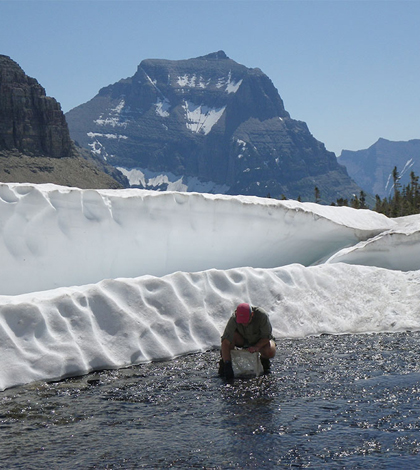Friday Follow-up: Sampling aquatic insects in Glacier National Park

Joe Giersch sets an insect sampling net in a Glacier National Park stream. (Courtesy Joe Giersch)
Last December, I talked to USGS aquatic entomologist Joe Giersch about his work tracking down the western glacier stonefly, an incredibly rare insect that lives only in the cold, glacier-fed streams of Glacier National Park. Those bug hunts produced a gloomy prognosis, finding the stonefly in just one of the only six streams where it had been known to exist. But the species also turned up in two other streams that Giersch had sampled as he traipsed around the park.
“I like to hike a lot in the park,” he told me at the time. “Pretty much any time I’m out hiking, whether it’s for work or personal amusement, I usually have one of these quantitative insect nets and will take samples in alpine streams anywhere in the park.”
The quantitative nets sit on the streambed and capture whatever aquatic insects flow from the sediment after a little stirring up. In an email conversation that didn’t make it into the final story, Giersch told me more about some of the custom tools he uses to capture adult insects that have emerged from the streams.
One of those instruments is the aspirator, a long-powered tool for sucking insects through tubing into a plastic chamber. Giersch’s model, pictured below, is a design he pursued for years for its cheap and sturdy qualities. “The inlet to if sucking hose has mesh covering the opening so that bugs in the chamber don’t go down the tube and into the mouth,” he wrote.

An aspirator design years in the making. (Courtesy Joe Giersch)
When he’s sampling for adult insects, Giersch sweeps streamside vegetation with a net, inverts it and aspirates the bugs out of the bag. His net, he wrote, is “really just a bag” that he’s pragmatically modified to fit over a retractable hiking pole.
“I have spent a lot of time trying to figure out the lightest, most bomb-proof methods and gear for the field, as we have to hike long distances into remote field sites,” he wrote. “If something breaks, we have to be able to repair, or otherwise make-do with what we have.”
Giersch also sent some photos of insect sampling in the park that didn’t make it into the post, but are still some of the best looking fieldwork shots I’ve seen.

Using a sweep net to collect adult insects. (Courtesy Joe Giersch)

Aspirating adult insects out of the sweep net. (Courtesy Joe Giersch)
Top image: Joe Giersch sets an insect sampling net in a Glacier National Park stream. (Courtesy Joe Giersch)




0 comments